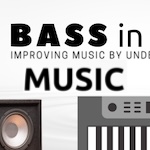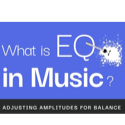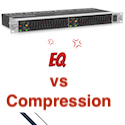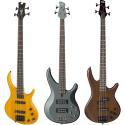The Bass EQ Elements For Improving Your Music
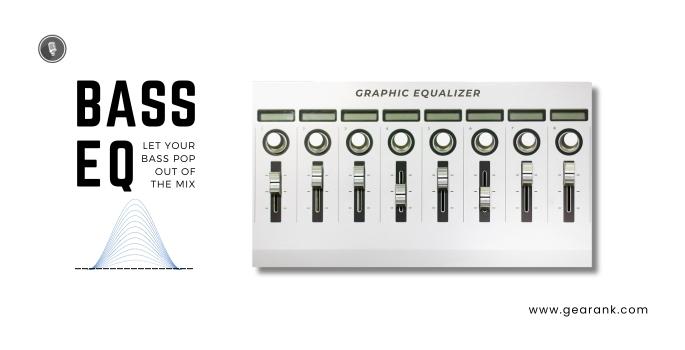
What is bass EQ? What is its role in music, and how does it affect your sound?
You'll often hear the term EQ in music production, which is short for Equalization. In general, this refers to the adjustments in the gain levels of specific frequency ranges.
Regarding bass, EQ mainly focuses on the low end of the sound spectrum.
EQ can make your bass stand out in the mix and provide clarity for the bass section in the song.
If you want to learn more about bass EQ and how to adjust it, then read on. This article will cover:
-
What is a Bass EQ?
-
How To EQ Bass?
-
Types of Bass EQ
-
Filters
-
Why Do You Need a Bass EQ?
-
Tips For EQing Bass Guitar
You'll gain another tool for shaping your tone by learning how to EQ bass. Let's begin by answering the core question...
What is Bass EQ?
Bass EQ is simply Equalization that is specific to the bass frequencies, it allows you to boost or cut certain frequencies in the bass range.
This can help you articulate your bass' sound and tailor-fit it to your preference or to compensate for the acoustics in a certain room.
To better employ EQ, it's essential to understand four concepts: frequency band, center frequency, gain, and bandwidth.
Frequency band refers to a range of frequencies.
The second concept is gain, which represents the volume level of your selected frequency band. The center frequency is the most affected, but nearby frequencies are also affected.
Sometimes, a frequency band is labeled by its center frequency, which is the frequency in the middle-frequency range.
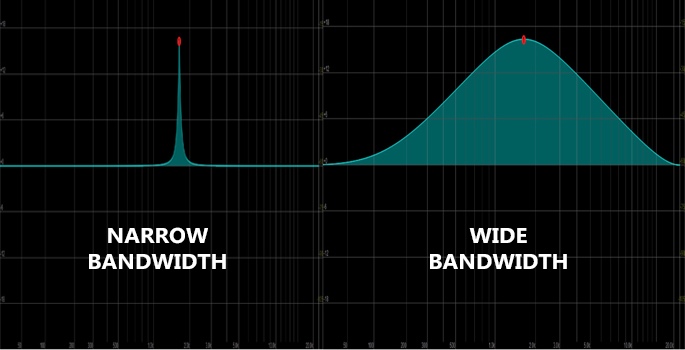
Lastly, bandwidth refers to the width of the adjustment. It can be used for narrow, wide adjustment, or anything in between. Note that simple EQs will usually have set center frequencies and bandwidths, while advanced EQs lets you fine tune these four elements.
3-band EQs found in amps are examples of basic EQs, giving you control over bass, mids, and treble.
The Boss GEB-7 bass EQ pedal takes it up a notch with seven sliders to control seven frequency band ranges, and a main gain control. This often used to EQ bass guitar and allows for surgical EQ tweaking. Some digital mixers and EQ plugins give you more control with adjustable center frequency and bandwidth.
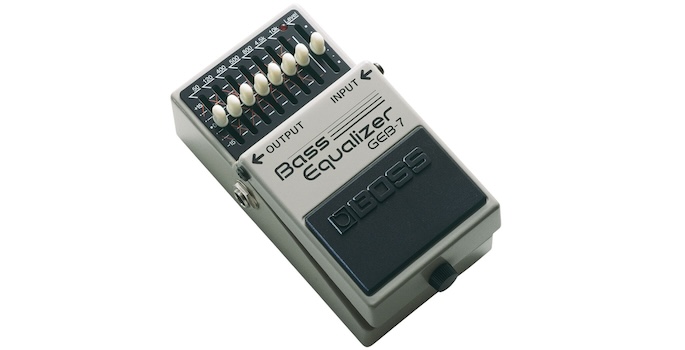
In this article we'll be focusing mainly on EQing the bass. There are different types of bass, from electric bass guitar, acoustic bass, upright bass, a synth bass, virtual instruments via MIDI, etc.
How To EQ Bass?
There are a several types of EQ. However, oftentimes, you'll encounter either a graphic EQ or a parametric EQ. Let's assume that you have one of the two.
-
Start from zero: If your EQ has a tone knob, place it at the 12 o'clock angle. If yours has sliders, place them in the center, if your using a parametric EQ set it on flat.
This allows you to hear the unaltered sound of your bass. In some cases, this setting is already enough as it interacts well with the acoustics of the room.
-
Consider the Room Acoustics: Room acoustics can affect the bass frequencies as well. Listen to your bass sound and how it interacts with the acoustics of the venue. Based on your observations, decide what type of adjustment you'll make.
-
Identify and Treat Frequency Issues: While listening to your bass's sound, check for unwanted frequency spikes, or frequencies that are being drowned. Once you've identified the problem frequencies, you're next move is to make adjustments on the frequencies. Below are some regions in the bass frequency spectrum you can refer to in adjusting your bass EQ.
While there's no set rule on this, here are some general guidelines on EQing bass. You can use this as a general starting point, but feel free to make some adjustments on your own.
-
20Hz-60Hz: Also referred to as sub-bass frequencies, this range covers the lower end of the bass spectrum. This frequency level is what you feel in a live setting.
It's the one that gives you that pumping feeling in your chest. At this frequency range, the human ear is said to be the least sensitive.
That is why this frequency is usually boosted in bass tracks, to the point where we can physically feel the air vibrating.
-
60Hz-250Hz: This is the bass area, where low end instruments thrive, and provide the fundamental notes of rhythm. Around 90–200 Hz lie the bass signals of most modern music tracks. While around 250 adds some warmth to your sound. This is the frequency for bass guitars, bass clarinets, upright bass, bass ukulele and other bass instruments.
Boosting this range can cause muddiness, but cutting too much low frequencies will result in a thin sound. When it's balanced, this range should give warmth and movement to your tracks.
-
250Hz–500Hz: These frequencies are referred to as the "low-mid range" region. Generally, a slight scoop on this range can help improve the clarity of your mix.
Boosting this range a bit can help fatten up the guitar sound and snare drums. In addition, this range can also help a bass guitar cut through small speakers.
Too much of this frequency will make your mix sound flat or muted (muddy sound); too little will make it sound barren or weak.
-
500Hz-2kHz: This is midrange territory At this range, you have to be very careful because it's where the fundamental frequencies of most instruments reside.
On other high-pitched instruments, this range can sound flat and carry unwanted room tones. Boosting the 500Hz range will make it sound flat or muted but remain thin.
As an alternative, you can boost the 700–900 Hz range, as it adds clarity without muddying the low end. But be careful, as too much of this range and your tracks will honk.
Cutting the 1-2 kHz can help reduce some unwanted nasal sounds on vocals. But don't do it too much, as it will affect clarity.
-
2kHz-6kHz: This is the fundamental frequency for the vocals. The high-mids are also the primary attack sound range of percussive instruments. Boosting this range will make the sound pop out, but too much can cause hearing fatigue.
If you boost around the 3 kHz range, you can enhance the attack of almost all instruments. from drums, guitars, keys, and vocals. It's a great way to add clarity to your mix.
Boosting this range too much can make the sound edgy and harsh. On vocals, it can increase the "hiss." If you want to add presence to the vocals, you can try cutting the other instruments in this range, like the guitar. This will give you space for your vocals.
Our ears are mostly sensitive to this frequency range, so be careful when mixing the different sounds. It can be challenging because many instruments, including vocals, are fighting for the same frequency range.
When in doubt, always make way for the vocals in this range. You can try boosting the other instruments on other frequencies instead.
-
6kHz-20kHz: Often referred to as "brilliance" or "air" because the only frequencies this high are harmonics, which have a sparkly sound.
Around 6–8 kHz will form some hiss. You can remove it using a narrow-band EQ or a de-esser.
You can try boosting at around 12 kHz for a modern hi-fi sound using a high shelf. Just be careful, because too much of this can cause a piercing or shrill sound.
Use a high-shelf filter for a warm-vintage tone and gently roll off the highs. Rolling too much top end, and your mix will sound flat.
-
Consider the Overall Mix: Listen carefully as you adjust the bass EQ, and notice how it affects the entire mix. Consider the role of the bass in the song as well as your personal preference. This is especially important for bass guitar EQ settings.
Types of EQs
There are several types of EQs. Below is a list of some of the most common ones.
-
Graphic Equalizers: One of the most commonly used forms of EQ is graphic EQ. It can be found on a bass amp, pedal, and amp simulation software.
The device consists of multiple sliders that allow for precise adjustment of frequencies to either boost or reduce them as per individual preference.
-
Parametric Equalizers: This type of EQ is popular, especially for those working with audio through software. It's known for its flexibility, precision, and greater control.
With this type of EQ, you can adjust the gain, center frequency, and bandwidth to achieve the desired sound. It's widely used in professional music studios.
-
Shelving EQ: Frequencies above or below a chosen cutoff point can be boosted or cut by a shelving equalizer.
-
Dynamic EQ: This type of equalizer is called a dynamic equalizer because it adjusts the intensity of the sound waves in real-time. It's designed to modify specific frequencies only when triggered by certain signals. This kind of equalizer is commonly used in compressors and expanders.
-
Linear Phase EQ: A linear phase equalizer (EQ) can preserve the phase of an audio signal, even after applying EQ to it. This improves sound quality, as the original phase information is maintained throughout the processing.
-
Go to this link for more details on what is an equalizer.
Short Note on Filters
Another important tool for crafting a great bass tone is using filters. Filters can help shape the frequency range and response of your signal.
High-Pass Filter: This filter allows only signals above a certain cutoff point to pass through while cutting off the frequencies below that point. This filter is commonly used to remove or reduce unwanted bass or low end while maintaining the upper frequencies.
These filters are often utilized in sound systems to protect the speakers from low-frequency damage and in recordings to eliminate some low-end noise.
Low-Pass Filters: A low-pass filter works opposite a high-pass filter. It enables the frequencies below a certain point to pass through while blocking the frequencies above that point. In audio systems, a low-pass filter is used to regulate the treble in the signal by eliminating higher harmonics.
Bandpass Filters: A bandpass filter is a type of filter that allows a specific range of frequencies to pass through while blocking frequencies outside that range. It consists of both high and low pass filters. This type of filter is commonly used in audio production and is often found in graphic equalizers, where it can quickly boost or cut a specific frequency range.
Why Do You Need a Bass EQ?
The primary function of Bass EQ is to shape the tone of your bass sound. This tool allows you to customize your bass sound to suit your preferences. EQing your bass track can add clarity and definition. Since bass occupies the lower end of the sound spectrum, using an EQ allows you to manipulate your sound to fill only certain areas of the frequency. This helps your bass sound stand out from the mix and avoid overpowering other frequency content, resulting in a more balanced mix pleasing to the ears.
Additionally, different settings can offer different acoustics, with some settings having an overly pronounced bass while others have less. A bass EQ can help you shape your bass sound to compensate for these variations. This results in a more balanced sound that fits the location.
Moreover, different genres require different bass sounds. For example, electronic music often requires a more pronounced and powerful bass sound, while classical music requires a more balanced and natural tone. A bass EQ lets you manipulate your sound to fit these varied tone characteristics.
Tips For EQing Bass Guitar
-
Solo Your Bass: When trying to balance the bass with other instruments, you have a couple of options. You can listen to it in isolation (solo) or hear how it sounds with the other instruments. The former is excellent in mixing situations, while the latter is ideal for live sound.
You can EQ it at the same level as the kick drum, as the kick and bass usually sit at the same frequency level to get a good balance. This will help you better understand how the bass sounds on its own, and how it interacts with kick drums within the context of the song.
-
Use headphones or a subwoofer: Having acoustic treatment, particularly bass traps, in your mixing room and a high-quality studio subwoofer is ideal for achieving accurate sound.
However, if you lack such equipment, you'll need a pair of studio headphones that can efficiently and accurately reproduce the lower frequencies. This is crucial because if you can't hear the low-end clearly, you won't be able to make informed decisions.
Final Thoughts
Bass EQ plays a vital role in defining your bass frequencies overall tone and sound. It allows you to shape your bass instrument's tone, ensuring it fits perfectly in the mix.
When EQing your bass sound, consider how it interacts with the other frequencies and the venue.
A well-crafted bass EQ can produce a fantastic sound that blends perfectly with the other instruments, fulfilling its purpose as foundation for the rhythm.
Frequently Asked Questions
How Do You Know Which Area To Boost or Cut?
Pay attention to how your bass sounds in a particular room and note how it should sound in the context of the music. Begin using a flat EQ and then adjust the sound based on the room's acoustics.
What's an Active and Passive EQ?
Passive EQ circuits require no power supply, while active EQs do. Passive EQs cut frequencies using filters, while active EQs can boost or cut frequencies.
Should I EQ My Bass Differently for Live Performances and Recordings?
It's essential to adjust your EQ settings differently for live performances and recordings due to the presence of a room or venue.
Recordings are often done in smaller spaces, while live performances usually take place in larger environments with the presence of an audience. Therefore, you need to set your EQ differently for these two settings.
Contributors:
- Jerome Arcon - Co-writer
- Jerry Borillo - Illustrator



